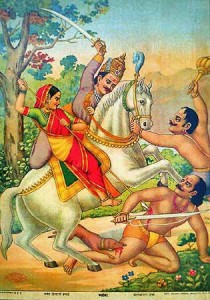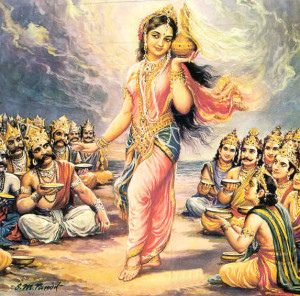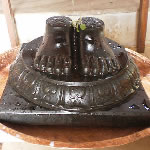The Samudra Manthan
Shri Mahalasa Narayani’s story is considered to be directly related to the story of Samudra Manthan or the Churning of the Sea, according to the Bhagwat Purana.
The Gods and the Asuras (Demons) churned the sea to get back the treasures which got immersed in the sea due to Sage Durvasa’s curse. During this churning process emerged the fourteen ratnas (treasures), including Amrut (nectar of life) which could make anyone who drinks it immortal.
There was a fight between the Gods and demons. In order to help the Gods, Lord Vishnu had to take the avatar (incarnation) of Mohini or the Enchantress.
She was so beautiful that the eyes of all demons got riveted on her face. In the meanwhile, she distributed Amrut to the Gods and nothing was left for the demons.
Shri Mahalasa is another name for Lord Vishnu’s Mohini Roopa (incarnation)!
There exists another reference to Mohini Avatar in Brahmanda Purana, but Mahalasa is associated with Mohini of Samudra Manthan only.
But there is another folklore as to how Mohini turned into Mahalasa. The legend has it that Lord Shiva was also enchanted by Mohini, who promised that when Lord Shiva will be born as Martand Bhairav. Mohini would marry him and at that time she would be called as Mahalasa.
In course of time Lord Shiva was born as Martand Bhairav and he conquered a demon called Malhar. Hence he was called Malhari, also known as Khandoba. Mohini was born in the house of Tima Shet and the child was named Mahalasa. Malhari later married Mahalasa and thus the concept of Mohini remained associated with Mahalasa.
In yet another folklore, Lord Shiva’s wife Parvati appeared to him as beautiful as Mohini. Thus, Parvati who was later Mahalasa, is also associated with Mohini incarnation.
However, in Mardol and other present-day temples, especially of those belonging to the GSB community, Mahalasa is dissociated from Shiva-Parvati concept and entirely regarded as the Mohini Roopa of Lord Vishnu only. The nomenclature Mahalasa Narayani distinctly corroborates this concept.
Shri Mahalasa Narayani, it may particularly be noted, also wears the holy thread, Yadnyopavitra, which is its unique feature.
The worship of this deity prevailed from the very ancient times among the Saraswat Brahmins from times before their settlement in Goa, or Gomantak as it was known.

Khandoba and Mahalasa killing demons Mani-Malla. Lithograph by Chitrashala Press, Poona. Photo courtesy: Wikipedia Commons
In the Sahyadri Khand of the Skand Purana, it is said that Parushuram brought 10 Saraswat families in Gomantak from their settlements in Trihotra in the North. These 10 families brought with them their following family deities:
Mangueshi, Mahadeva, Mahalaxmi, Mahalasa, Shantadurga, Nagesh and Saptkoteshwar.
Later, more Saraswat families came to Goa and they too brought with them their own family deities.
In all, there were 66 families which settled in Salcette taluka. Of them, six families settled in Varyenapur or Varunapur (old Mhaddol), commonly known as Vernem during Portuguese rule and Verna now.
There are many stories associated with how the idol of Mahalasa came to be installed in the temple at Mardol. But the migration of this deity took place from Varunapur or Verna to its present place during the middle of the sixteenth century.
While the minute details are not known, it is evident that this migration took place during the persecution launched by the Christian missionaries during the Portuguese rule.
The Mardol temple is about four and a half century old. In the Year Shaka 1789, Prabhav Samvatsar, the temple was repaired and a copper roofing was fixed. A copper plate inscription in the temple describes this event. Barring this, the entire other original construction is untouched and is indicative of the ancient exquisite workmanship.
The idol of Shri Mahalasa is in standing position and has four hands; there is a Trishul (trident) in the right back hand and an Amrut Kumbha in left back hand.
A demon, Virochan, is kneeling at the right hand side and he appears to have been held by hair in the right forehand. There is a demon under her feet, and the severed, bleeding head of a demon in her left hand, under which a lion (there are some differences among scholars on the animal) appears to be licking the trickling blood.
On the Prabhaval in the background, the name Shri Mahalasa is inscribed in Devanagari along with Shankha (Conch), Chakra (Disc), Sesha, and so on, which signify the association with Lord Vishnu.
![]() || SHRI MAHALASA ARPANAMASTU ||
|| SHRI MAHALASA ARPANAMASTU ||





